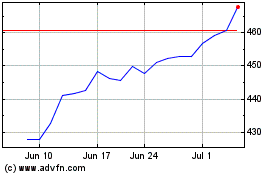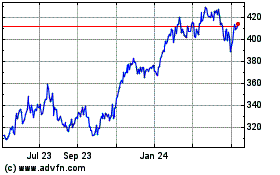By Jack Nicas and Laura Stevens
This article is being republished as part of our daily
reproduction of WSJ.com articles that also appeared in the U.S.
print edition of The Wall Street Journal (October 27, 2017).
Three of the world's biggest companies -- Google parent Alphabet
Inc., Amazon.com Inc. and Microsoft Corp. -- reported booming
quarterly growth, extending their reach in industries from
advertising to retail to business software as they drive the
economy's technological transformation.
Alphabet on Thursday said profits spiked 33% in the third
quarter as users clicked on more ads on smartphones, atop search
results and before YouTube videos. Amazon, meanwhile, said its
revenue grew by 34% and profits inched up, shrugging off concerns
that heavy investments in new warehouses and hiring workers would
push it to a loss. And Microsoft reported a 12% revenue increase,
capitalizing on a shift to cloud computing.
The technology industry's banner day underscored the dominance
of a handful of companies in the internet age -- and foreshadowed
more expansion, including into new businesses.
Alphabet reported a 40% increase in nonadvertising revenue to
$3.41 billion, showing the strength of its relatively new
cloud-computing business, which sells computing power to other
companies over the internet. And pharmaceutical stocks fell
Thursday after the St. Louis Post-Dispatch reported that Amazon had
obtained licenses from several state pharmaceutical boards. The
licenses are for Amazon to sell some medical wholesale equipment,
according to a person familiar with the matter.
"The strong keep getting stronger," said Colin Sebastian, a
Robert W. Baird & Co. analyst who covers Amazon, Google and
Twitter Inc. "The bigger drivers of their operations -- secular
growth trends in e-commerce and digital advertising -- are still
very strong."
Shares in three tech giants jumped in after-hours trading,
adding a combined $80 billion in market value in the first hour or
so after results were announced. Alphabet and Amazon's stocks both
surged past the $1,000 mark and approached all-time highs.
But their rising fortunes are also drawing new scrutiny and
questions about whether they have grown too powerful.
Lawmakers have proposed new transparency rules for digital
political ads after Google, Facebook Inc. and Twitter said Russian
actors ran ads on their sites around the 2016 election. The
platforms face wider criticism of their roles in spreading
misinformation and hateful messages on the internet. European
competition regulators in June fined Alphabet $2.7 billion for
abusing its internet-search dominance, and they are investigating
other aspects of its business. Alphabet denies the charges and has
appealed the fine.
Advertisers, too, are wary of the increasing power of a few
digital-ad businesses, amid allegations of ad fraud and shoddy
metrics, and brands' ads running next to unsavory YouTube videos.
On Thursday, Twitter said it mistakenly overstated its number of
users for the past three years. Yet their businesses continue to
flourish, in part because of one fundamental trend: surging
internet usage world-wide.
"Are you going to use the internet less next year?" said
Macquarie Capital analyst Ben Schachter. "These are already some of
the largest companies in the world, and they are continuing to
expand."
The tech-earnings triumph extended beyond the three giants. Chip
maker Intel Corp. said its profits rose 34% to $4.52 billion and
lifted its outlook for the year. Even Twitter, which has struggled
for years, narrowed its quarterly loss to $21.1 million, from $103
million a year prior, and forecast that next quarter it could earn
its first profit since going public in 2013. Twitter shares rose
18.5%. Two other tech giants -- Apple Inc. and Facebook -- are due
to report earnings next week.
Amazon's quarterly revenue hit a new record in the third quarter
at $43.74 billion, as it expanded into more corners of consumer
spending. The third quarter for the first time included Amazon's
$13.5 billion acquisition of Whole Foods Market Inc., which closed
in late August.
The jump in revenue is but one measure of Amazon's scale.
Marketing-research firm eMarketer estimates Amazon will command
some 43.5% of e-commerce sales this year, compared with 38.1% last
year.
Amazon's profit increased 1.6% to $256 million, even though the
third quarter is typically a period of heavy spending, when Amazon
opens new warehouses to get them up and running in time for the
holidays. The company's total number of employees increased to
541,900 from 382,400 in the second quarter, including roughly
87,000 Whole Foods employees.
Alphabet, with 78,100 employees, said its quarterly profit grew
to $6.73 billion on revenue of $27.77 billion. The company's core
business of selling ads in search results and on YouTube grew at
its fastest rate in a year, 22.6%. "The core search business is
just super-strong," said JMP Securities analyst Ron Josey. Google's
search ads "continue to be a must buy for advertisers."
The amount advertisers paid Google per ad click rose by 1% from
the second quarter, the first such increase since the first quarter
of 2016. Advertisers' cost per click has been dropping for years as
they bought more mobile ads, which are generally cheaper than those
on desktop computers. Analysts said this quarter's increase
suggests advertisers are willing to pay more for mobile ads, which
could be another boon for Google's business.
Microsoft's revenue surged on the strength of its emerging
business of selling web-based, on-demand computing services. In the
fiscal first quarter, the two biggest pieces of Microsoft's
cloud-computing operations -- its Azure infrastructure services and
Office 365 online-productivity business saw revenues soar 90% and
42%, respectively. Overall, Microsoft's profits increased 16% to
$6.58 billion. Revenue reached $24.54 billion.
"The secular shift from off-line to online is continuing to gain
steam and gather momentum," Mr. Josey said. "You're seeing that
every single quarter, and I don't know what gets in its way."
--Jay Greene, Ted Greenwald and Georgia Wells contributed to
this article.
Write to Jack Nicas at jack.nicas@wsj.com and Laura Stevens at
laura.stevens@wsj.com
(END) Dow Jones Newswires
October 27, 2017 02:47 ET (06:47 GMT)
Copyright (c) 2017 Dow Jones & Company, Inc.
Microsoft (NASDAQ:MSFT)
Historical Stock Chart
From Mar 2024 to Apr 2024

Microsoft (NASDAQ:MSFT)
Historical Stock Chart
From Apr 2023 to Apr 2024
